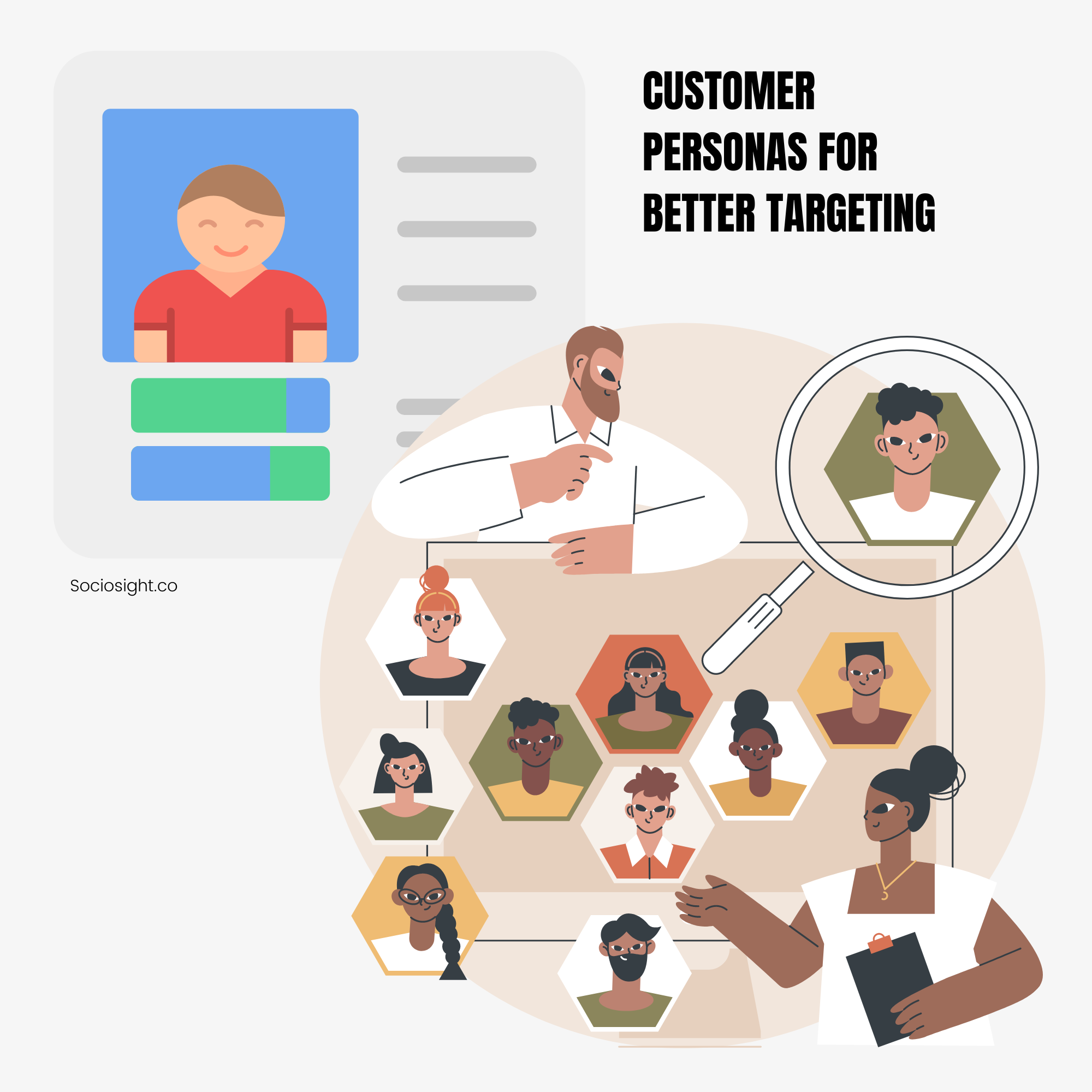Before creating content and launching your social media campaigns, you must understand who you’re trying to reach.
You want to avoid guessing your target audience, do you?
After all, how can you expect them to listen if you don’t know whom you’re talking to?
That’s why getting to know your target audience in marketing strategy is essential.
Who is your target audience? What do they like? What do they need? What motivates them?
The more you know about your target audience, the better you can tailor your social media marketing efforts to resonate with them.
That’s when the customer persona comes on board!
Table of Contents
7 Benefits of Customer Personas for Your Social Media Marketing Strategy
A customer persona is a made-up version of your ideal customer based on actual data about your target audience.
For example, let’s say your target audience is working mothers.
You might know they’re busy and always on the go, but do you know what content they prefer to consume on social media? Do you know what types of products or services they’re interested in?
Do you struggle with managing multiple social media platforms for your brand's presence?
The Sociosight app can help you simplify the process and save you time. With Sociosight, you can publish, schedule, and monitor posts and engage with your followers across multiple social media platforms, all from one dashboard.
Get started today with a free sign-up!
Register Now for Free

By creating a customer persona of a working mother, you can get a deeper understanding of what makes her tick and what types of content and messaging will resonate with her.
You can create content batching to present a series of social media posts tailored to her needs and interests.
On the other hand, if you make assumptions about your target audience without really understanding them, you risk missing the mark with your social media content management and failing to engage your audience.
So, what are the benefits of using customer personas in your social media marketing strategies?
Let’s find out!
![Avoid Ineffective Audience Targeting: 7 Benefits of Customer Personas in Social Media Marketing Strategy [Guide & Infographic] 1 Customer Personas for Better Targeting - Sociosight.co - Social Media Management](https://sociosight.co/media/2023/02/customer-persona-410x1024.png)
Improved Targeting
Customer personas provide a more in-depth understanding of your target audience, including their demographic, geographical, psychological, and behavioral profiles, perspectives, and interests. This allows you to create a more focused and effective social media marketing strategy.
For example, suppose your target audience is working professionals in their 30s and 40s. In that case, you can create content and campaigns that cater to their busy schedules and need for convenience.
By tailoring your content and campaigns to meet your target audience’s specific needs and interests, you can increase the chances of your campaigns resonating with them, leading to higher engagement rates and ultimately driving more business.
Better Awareness of Customer Habits
Creating customer persons allows you to determine where your target audience spends their time online.
For example, suppose your target audience is primarily active on LinkedIn. You can focus your social media presence on that platform to reach where they are most active.
Another example is assuming your target audience is active on multiple social media channels.
You can create tailored content for each platform to cater to their needs and purposes.
For efficiency, consider using a social media scheduling tool like the Sociosight App to save time publishing your content across multiple platforms.
Improved Customer Experiences
Customer personas provide a deeper understanding of your target audience’s motivations, pain points, and habits, allowing you to create content and campaigns that meet their specific needs and preferences at each stage of their journey with your brand, called a customer journey.
For example:
At the awareness stage, if your target audience is looking for information about a specific problem or issue, you can create content that provides helpful information and addresses their pain points.
For example, suppose your target audience is new parents. You can schedule social media posts about how to care for a newborn baby, addressing their pain points.
At the consideration stage, if your target audience is evaluating different solutions to their problem, you can create content highlighting the benefits of your product or service that aligns with the answer they seek.
For example, suppose your target audience is interested in eco-friendly products. You can create content highlighting the benefits of your eco-friendly product and addressing their specific needs, increasing their engagement with your brand.
At the decision-making stage, if your target audience is ready to make a purchase, you can create content that makes it easy for them to take the next step, such as filling out a form or making a purchase.
For example, you can create a landing page that includes a form for your target audience to fill out to receive a free product sample.
You can then promote your landing page link on social media platforms where your target audience is active. Doing so will increase the chances of converting high-quality leads into customers.
Consistent Brand Messaging:
With a clear understanding of your target audience, you can create consistent messaging that resonates with them across all of your social media channels.
This consistency helps to build your brand and increases the impact of your marketing efforts.
Consistent brand messaging is crucial for building and maintaining your brand image.
Customer personas provide a clear understanding of your target audience, which helps you create consistent messaging across your social media channels, such as Facebook, Instagram, Twitter, etc.
You can achieve this consistency by creating content pillars for each social media platform where your target audience is most active.
A content pillar is a recurring theme or message central to your brand’s messaging.
For example, suppose your target audience is young families. Your content pillar might be “Providing healthy and natural food options for children.” This pillar is the foundation for all your social media content, ensuring that your messaging is consistent and resonates with your target audience.
Then, you can develop more specialized sub-pillars of content for more tailored messaging on each social media platform where your target audience is most active.
For example, suppose your target audience is most active on Facebook. You can create a content pillar that educates young families about the benefits of organic food for children.
You can create posts highlighting the dangers of artificial additives and preservatives and how your products are free from these ingredients. You can also create posts that offer tips and advice for feeding children a healthy and balanced diet.
Another example is if your target audience is most active on Instagram, you can create a content pillar that focuses on showcasing your products in a visually appealing way.
You can create posts highlighting the ingredients in your products, share recipes that incorporate your products, and showcase your products in use. You can attract your target audience and build brand awareness by using eye-catching visuals.
Utilizing customer personas allows you to anticipate the optimal times to post, particularly if you need more data to analyze from your social media analytics. This ensures that your target audience is exposed to your content during their most active periods.
By creating content pillars for each platform where your target audience is most active, you can ensure consistent brand messaging across your social media channels. This consistency can lead to increased engagement and improved results for your social media marketing efforts.
Improved Team Collaboration:
Customer personas help ensure consistency across your business by getting everyone on your team on the same page when it comes to understanding your target audience.
Imagine you run a small business that sells organic skincare products. Your target audience is women in their 30s and 40s who are concerned about the ingredients in the products they use and want to avoid artificial additives and preservatives.
By creating a customer persona for this target audience, you can understand their concerns more deeply. Also, you may learn that they are most active on Instagram and prefer visually appealing content that highlights the natural ingredients in your products.
Your marketing team can create content and campaigns that cater to your customer personas with this information. For example, they can make Instagram posts highlighting the benefits of organic skincare and showcasing the natural ingredients in your products.
Your sales team can use the customer persona to guide their outreach efforts, targeting women in their 30s and 40s who are interested in organic skincare. They can also use the customer persona to determine the best times to reach out, ensuring that their efforts are seen by your target audience when they are most active.
Your customer service team can also use the customer persona to provide better support to your target audience. For example, they can use the customer persona to anticipate common questions and concerns, allowing them to provide more informed and helpful responses.
You can create a more cohesive and effective social media marketing strategy using customer personas to guide your team’s efforts. This can lead to increased engagement and improved results for your business.
Enhanced Analytics for Improved Decisions
Customer personas provide a deep understanding of your target audience, including their behaviors, motivations, and preferences. This information helps you make informed decisions about your marketing strategy, such as which channels to use, what content to create, and when to post it.
However, customer personas are just one piece of the puzzle. To truly optimize your social media marketing strategy, you must understand how your efforts perform in the real world.
That’s where social media tracking or analytics comes in.
Social media analytics provides real-time data about the effectiveness of your marketing efforts. It allows you to see how your target audience engages with your content and when to post it.
Also, you can monitor which channels are driving the most traffic and which campaigns are delivering the best results. You can adjust your marketing strategy to achieve better results with this information.
Let’s look at examples of how customer personas and social media analytics data help you make better decisions on your social media strategy.
Let’s say you’re a small business owner who sells natural skincare products.
You’ve created customer personas for your target audience and determined that one of your personas, “Eco-Conscious Emma,” is the most likely to purchase your products.
Eco-Conscious Emma is a young professional who values natural and sustainable products and is interested in the health benefits of using natural skincare products.
Scenario-1
Based on the customer persona “Eco-Conscious Emma,” you created a social media marketing campaign focused on the health benefits of your natural skin care products and targeted it specifically to Eco-Conscious Emma.
You created a series of Instagram posts and stories highlighting the natural ingredients in your products and the benefits they provide for skin health. You also targeted your ads to users who follow eco-friendly and wellness-related accounts on Instagram.
After running the campaign for several weeks, you use Instagram analytics to analyze the results.
You look at metrics such as engagement, conversion, and click-through rates, and you see that your campaign is performing well. Your engagement rate is high, and you’re getting a lot of clicks on your ads.
Now, you can use the information from your analytics to make informed decisions about your marketing strategy.
For example, your engagement rate is highest on Instagram stories. In that case, you may create more Instagram stories in the future to reach your target audience. Or, if your conversion rate is highest for users who follow eco-friendly accounts, you may decide to target your ads specifically to these users in the future.
This way, customer personas help inform your marketing strategy. At the same time, your analytics tool provides the data and insights needed to optimize your results.
You can make informed decisions that improve your business results using customer personas and social media analytic tools.
Scenario-2
Suppose you’ve run your social media marketing campaign targeting Eco-Conscious Emma for several weeks, and you’ve analyzed the results using the analytics tool. But, to your surprise, the post doesn’t perform as well as you expected. Your engagement rate is lower than you hoped, and your conversion rate is lower than you predicted.
In this situation, you need to adjust your marketing strategy based on the insights from your analytics.
Here are a few ideas you may consider:
- Re-evaluate your customer persona: It’s possible that your customer persona of Eco-Conscious Emma needs to be more accurate than you thought. You may need to re-evaluate your customer persona and gather more information about your target audience to ensure you clearly understand their behaviors, motivations, and preferences.
- Refine your marketing message: If your message is not resonating with your target audience, you may need to refine it. Use the insights from your analytics tool to understand what your target audience is not responding to and adjust your messaging accordingly.
- Try a different channel: If your target audience is not engaging with your content on Instagram, you may need to try another channel. Consider creating a blog, starting a YouTube channel, or launching a TikTok account to reach your target audience where they are most active.
- Experiment with different content formats: If your target audience is not responding to your Instagram stories, you may need to experiment with other content formats. You could try creating Instagram posts or reels to reach your target audience differently.
By making these adjustments, you can ensure that your marketing strategy is aligned with your target audience’s preferences and behaviors. And by continually monitoring your social media analytics, you can make ongoing improvements to your social media marketing efforts and achieve better results for your business.
Customer Personas and Social Media Analytics Work Hand in Hand
So, customer personas predict your target audience’s preferences and behaviors. On the other hand, social media analytics provide actual data about the effectiveness of your marketing efforts. Combining these two tools allows you to create a more effective and efficient social media management and marketing strategy.
With customer personas, you can make informed decisions about channels, content formats, and messaging strategies to reach your target audience. Then, by using your analytics to measure the results of your efforts, you can validate your predictions and make adjustments as needed to improve your marketing performance.
This way, customer personas and your analytics tool work hand in hand to help you create a social media marketing strategy optimized for your target audience and your business goals.
Improved Product Development: How Customer Personas Help Your Business Innovate and Grow
Gaining a deep understanding of your target audience’s needs, interests, and pain points through customer personas allows you to have information that will guide your product development efforts.
For example, let’s say you run a clothing company and have created a customer persona named Trendy Tanya, a fashion-forward college student constantly searching for the latest styles with eco-friendly materials.
Here’s how customer personas can help improve product development for your customer persona, Trendy Tanya.
Product Innovation
With Trendy Tanya’s preferences and behaviors in mind, you can prioritize your product development efforts to create new products that will appeal to her specifically.
You could create a line of clothing designed explicitly for Trendy Tanya that incorporates the latest fashion trends and is made from eco-friendly materials.
For example, you create the “Eco-Chic Collection,” a line of fashionable and eco-friendly clothing explicitly designed for Trendy Tanya and her love for style and sustainability.
This collection could include a range of clothing pieces such as dresses, tops, skirts, and pants made from sustainable materials like organic cotton, bamboo, and recycled polyester.
The clothing could also feature unique designs and prints inspired by the latest fashion trends, focusing on affordability and versatility for college students like Trendy Tanya.
The packaging could also be eco-friendly, using biodegradable or recycled materials.
By offering Trendy Tanya a combination of style, sustainability, and affordability, this Eco-Chic Collection could appeal to her love for fashion and the environment.
Customer Feedback Loop
Customer personas can help you get feedback from your target audience on your product development efforts.
By connecting with Trendy Tanya through social media, you can get valuable insights into what she likes and dislikes about your products.
For example, you could use social media platforms like Instagram and Facebook to run polls and surveys, asking your target audience in Trendy Tanya customer personas for their opinions on different fashion trends, eco-friendly materials, and affordable clothing options.
So, with customer personas, you can create better-suited products for your target audience, resulting in increased customer satisfaction and loyalty. You can grow your business and achieve long-term success by continually innovating and improving your outcomes.
Conclusion
In conclusion, customer personas are crucial to improving social media marketing strategies.
Understanding your target audience’s profiles, preferences, and interests allow you to improve targeting, have a better awareness of customer habits, improve customer experiences, have consistent brand messaging, improve team collaboration, enhance your performance tracking, and improve product development.
By leveraging the benefits of customer personas, you can increase your chances of success in your social media marketing efforts, resulting in increased engagement, high-quality leads, and, ultimately, higher conversion rates.
The key to successful social media marketing is knowing your target audience, and customer personas can help you achieve that.
So, do you find customer personas help to achieve your social media marketing goals?
I was hoping you could share your thoughts in the comment section or drop me an Instagram DM at @sociosight.co.











